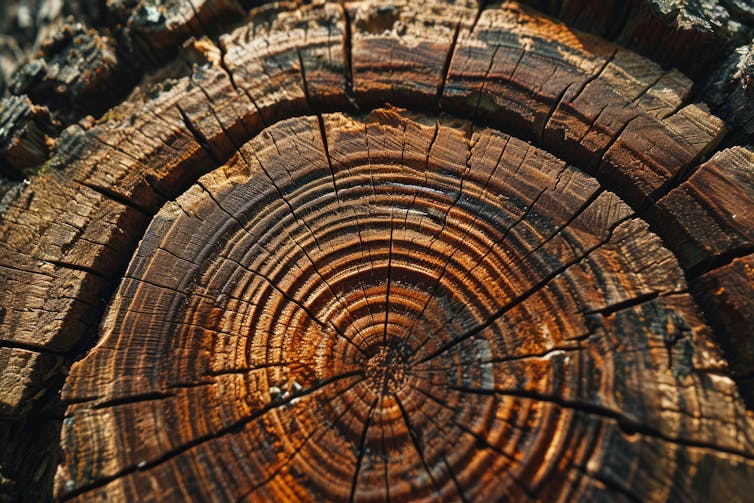
In September 1859, the same year that Darwin published On the Origin of Species, telegraph systems across Europe and North America stopped working and started sparking, leading to fires in some cases.
Just hours before, researchers had observed the first ever confirmed solar flare – an intense burst of radiation emitted from the Sun. It was a warning something big was about to hit our planet. Most of the northern and southern skies lit up with brilliant auroras (northern and southern lights) signalling that a massive solar storm was underway.
This storm, later named the Carrington event, was one of the strongest in documented history. However, in a recent article in Nature, we have shown that in the not-so-distant past, the Earth was battered by much more extreme solar storms. Evidence of these storms has come, in particular, from analysing levels of radioactive carbon – known as radiocarbon, or carbon-14 – in tree rings.
Solar storms cause disturbances in the Earth’s magnetic shield, or magnetosphere. One frequent way they are caused is by coronal mass ejections – outpourings of charged particles from the Sun – that make their way to Earth and penetrate the magnetosphere. Extreme solar storms could spell disaster for our highly technological society because they have the potential to damage satellites and bring down communications networks and global electricity grids.
The strength of some past extreme solar storms detected in tree rings suggest they would have played havoc with our technological infrastructure on a scale never seen before. One extreme solar storm known to have occurred in AD774, for example, would have dwarfed the Carrington event.
Measuring radiocarbon
Radiocarbon, or carbon dating, has been widely used for decades to age objects that were once alive, such as bone, wood and leather. When plants and animals die, the radiocarbon inside them decays at a predictable rate. So by measuring how much radiocarbon is left in an object such as bone, scientists can estimate how long ago the organism died.
However, in the last decade, scientists have discovered that extreme solar storms can affect the amount of radiocarbon absorbed into living organisms such as trees. This provides researchers with the opportunity to search for extreme solar events not recorded by the history books and to precisely date them.
The amount of radiocarbon in the atmosphere varies over time, which can make radiocarbon dating give misleading ages. There have therefore been extensive efforts over the years to “calibrate” the radiocarbon record to make it more accurate. This means relating it to other material of known age. These might be trees which can be dated through their growth rings, or stalagmites and corals which have been dated using other methods.
When combined with the science of determining ages from tree rings (dendrochronology), the radiocarbon signature of an extreme solar storm can provide a reference point to the exact year. This could help make radiocarbon dating even more accurate.
By reviewing the available evidence for these extreme solar storms we can now try to figure out how often these events occur. The evidence tells us many things about the global carbon cycle, ocean and atmospheric circulation (how heat is redistributed over the Earth’s surface), and the workings of the Sun.
Solar storms change radiocarbon in trees
In 2012, a team led by Fusa Miyake, at Nagoya University in Japan, discovered that extreme solar storms could produce abrupt changes in the radiocarbon concentrations found within tree rings. Before this, radiocarbon production rates were not thought to vary substantially over short time periods and so annual measurements of past radiocarbon were unlikely to be of particular interest.

They identified the massive spike in radiocarbon production in the atmosphere associated with the AD774 extreme storm. Other extreme events have since been confirmed to have occurred in AD993, 660BC, 5259BC and 7176BC. The most extreme solar storm we have detected in the radiocarbon record took place around 14,370 years ago, towards the end of the last ice age.
We do not yet know if these events are simply larger-scale versions of regular solar storms – so-called “Black Swan” events – or if they are caused by distinct physical phenomena. As more extreme solar storms are identified from the radiocarbon record, they will add to our knowledge of physical processes occurring in our parent star.
One of the biggest threats from a large solar storm is its potential to instantly kill the entire satellite fleet (except for those low-altitude satellites that are permanently protected by the geomagnetic field), as well as to bring down power grids. Being able to forecast these events and give advance warning to grid operators is vital.
In coming years, the radiocarbon record could well reveal more extreme solar storms. The scientific community is racing to analyse old trees from different regions of the world with the goal of strengthening existing evidence and discovering new extreme solar storms of the past.
Enhancing our understanding of these extreme events is not only important for
precise radiocarbon dating but also for understanding processes happening on the Sun and on our own planet. It can also assist us in preparing for the next extreme solar storm. We can’t yet forecast when it will happen, but new insights into the past tell us that there will be one sooner or later.
Maarten Blaauw, Professor, School of Natural and Built Environment, Queen’s University Belfast; Ilya Usokin, Professor of Space Physics, Department of Space Physics and Astronomy, University of Oulu, and Tim Heaton, Professor of Applied Statistics, Faculty of Engineering and Physical Sciences, University of Leeds
This article is republished from The Conversation under a Creative Commons license. Read the original article.











